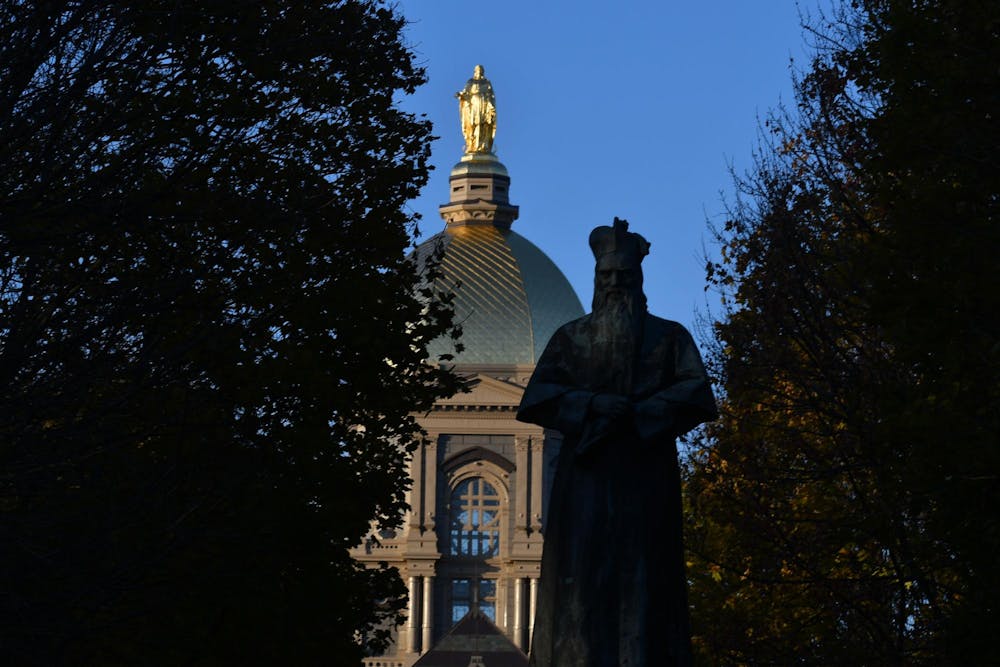The Notre Dame endowment has ended the 2023 fiscal year at the same value it began — $18.9 billion. Between July 2022 and June 2023, the endowment returned 1.32% and paid out $559 million to fund financial aid, academic programs and operations.
Public markets rebounded this year, but the University endowment did not manage to keep up with inflation. The endowment’s return broke free from last year’s negative slide but failed to outclass investing benchmarks. Private equity, once the driver of Notre Dame’s outsized endowment returns, dragged returns below the public markets in fiscal 2023.
“A rebound in the public equity markets was offset by a reduction in private equity valuations, particularly venture capital,” the annual report said.
Public indices and the University’s own internal benchmark tower above this year’s 1.32% endowment return. Over the same fiscal year, the S&P 500 returned about 16.3%, and the University’s strategic policy portfolio, an internal benchmark of public market indices, returned 11.5%. The endowment also lost buying power, failing to keep up with the 3% rate of inflation between July 2022 and June 2023.
Since 2000, the endowment has earned higher returns than the internal benchmark except in 2009 and in 2023. More than a decade has passed since the endowment return did not exceed the strategic policy portfolio. In 2009, the comparison portfolio returned -19.5% while the endowment returned -20.8%. This year’s underperformance is much larger. The report notes that the strategic policy portfolio can have low short-term correlations with the endowment.
After seven interest rate hikes from the Federal Reserve during the fiscal year, private equity exposure stifled investment returns. Notre Dame believes below-market returns are only temporary. Notre Dame’s endowment ranks in the top-ten largest in the U.S. and rivals the GDP of several countries, including Jamaica and Mongolia.
“Notre Dame is fortunate to have one of the highest-quality, best-performing private equity portfolios in the country,” executive vice president Shannon Cullinan wrote in an email. “We are very long-term investors and are comfortable with short-term periods of volatility in returns.”
The endowment pool is composed of 48.3% private equity investments. The portion invested in private equity has grown significantly over the last few years, up from 26.8% private equity in 2017 and 19.8% in 2002. Private equity firms typically buy companies and restructure them to increase profit and efficiency before selling them at a markup. Most retail investors have limited access to private investments, but big-money funds and endowments have capitalized in recent years.
Jason Reed, associate faculty director of the Notre Dame Institute for Global Investing, said private markets have become “increasingly attractive for outsized returns” among many endowments, pension funds and retirement funds. Despite a downturn this year, Reed said in an email that 2024’s private equity outlook is positive. Reed added that endowments have a long-term focus and that Notre Dame’s has a “storied history of success that will surely continue.”
Cullinan wrote that private equity has been the endowment’s highest-performing asset class for decades, “generating more than double the investment returns of the public equity markets over long periods of time.” The annual report notes that private equity is the reason for the endowment’s long-term success, even if it resulted in low returns this year.
According to Bloomberg News, private equity returns in 2023 dipped to their lowest level since the global financial crisis 15 years ago. Increasing interest rates made it difficult for private investors to sell investments and launch initial public offerings. As federal interest rates increased from about 1.75% to 5.25% in less than a year, private equity and venture capital deals dried up. According to a report by Bain & Company, private equity deal value declined 37% and exit value plummeted 44%. Now that interest rates have stabilized, the report notes abundant capital ready to deploy in 2024.
Reed said that central bank policy rates were “the biggest reason for PE and VC valuations to decline,” but that “short-term interest rate movements, even over the course of a year, have limited impact on [endowments'] long-term outcomes.“
Notre Dame’s returns are similar to many other large university endowments with the same fiscal calendar. Harvard’s endowment returned 2.9%. MIT and Duke posted endowment return losses this year. Dartmouth, the University of Pennsylvania and Yale all ended the year below 2%. Other large university endowments adopt a similar strategy with a large percentage of money invested in private equity.
“The long-term success of the endowment is where the focus should be,” Reed said about endowments in general. “Short-term headwinds will inevitably happen, but investment offices continue to find excess returns across various strategies and assets.”
Earlier this month, news broke that chief investment officer Mike Donovan decided to retire. Donovan led the endowment for four years after his former roommate Scott Malpass retired in 2020. Before taking on the role of chief investment officer, Donovan worked in the office for 27 years.
Effective July 1, Tim Dolezal will be chief investment officer, overseeing $18.9 billion in assets. Dolezal was the valedictorian for the Class of 2002. Dolezal declined to comment on this year’s endowment return.
“Mike and Tim have worked closely together as partners for over 20 years, so this is a seamless generational transition,” Cullinan wrote in an email.
Despite this year’s modest return, the endowment paid out $559 million, a 10% increase from last year. Cullinan said payout growth is calculated based on “the most recent 3-year investment performance to buffer against short-term market volatility in one particular year.”
The payout is the University’s largest individual source of operating revenues, but about two-thirds of its value is earmarked for specific purposes due to donor restrictions. The endowment is a collection of more than 7,000 individual funds that allow donors to direct money to a specific purpose. Tuition revenue remains a source of cash that is not donor-restricted.
As the endowment has grown over the last two decades, the amount paid out to cover financial aid, academic programs and similar initiatives has also increased.
About 41% of the endowment payout, $216 million, funded scholarships and fellowships. Another 41% is divided between academic program support and faculty chair pay. The remaining funds went toward general operations, athletics and other expenses.
“The largest portion of the endowment payout each year goes to financial aid, which makes a Notre Dame education affordable and accessible,” Cullinan said.
Tuition increased by 2.5% between 2022 and 2023, slower than the rate of inflation. Net tuition, after accounting for financial aid and fellowships, decreased from $369 million in fiscal 2022 to $364 million in fiscal 2023. The amount of money the University collected from tuition declined overall.
Half of all first-year students received need-based aid this year, with an average award exceeding $48,000. The endowment is a key factor in allowing Notre Dame to offer need-blind admission to all U.S. students who apply and meet 100% demonstrated financial need for all admitted students, Cullinan said.
The annual report also noted that Notre Dame received $216 million in research awards for fiscal 2023. The 824 awards set a record for the largest amount in the University’s history. Federal agencies paid for the largest share of the funding, with the National Science Foundation contributing $42.5 million, the Department of Defense $35.8 million, the Department of Health and Human Services $32.2 million, the Department of Energy $16.7 million and the Department of Education $11 million.
Academic and non-academic staff also received wage increases this year, totaling $92 million in raises based on merit and inflationary pressure, according to the report.










